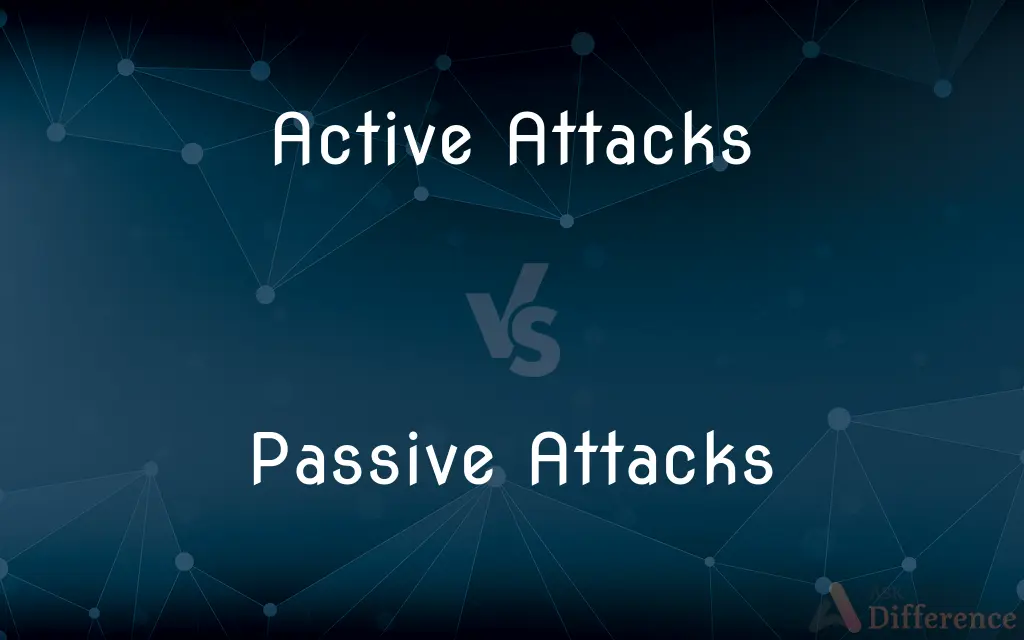Active Attacks vs. Passive Attacks — What's the Difference?
By Tayyaba Rehman — Published on January 10, 2024
Active Attacks are deliberate actions to breach security, like hacking or malware. Passive Attacks are unauthorized monitoring to gather information secretly.

Difference Between Active Attacks and Passive Attacks
Table of Contents
ADVERTISEMENT
Key Differences
Active attacks are deliberate attempts to breach the security of a system or network. In these attacks, adversaries take proactive actions, often involving intrusion or exploitation of vulnerabilities. Examples include hacking, malware distribution, and denial-of-service (DoS) attacks. The goal of active attacks is typically to compromise, disrupt, or damage the targeted system.
In contrast, passive attacks focus on unauthorized monitoring and eavesdropping to gather information without altering the target system. These attacks aim to remain undetected while silently collecting sensitive data. Passive attacks include activities like wiretapping, sniffing network traffic, and passive reconnaissance. The primary objective of passive attacks is information gathering rather than direct disruption.
The key difference between active and passive attacks lies in the attacker's level of engagement. Active attacks involve proactive and noticeable actions that can directly harm the target, while passive attacks prioritize covert data interception and maintain a lower profile.
Understanding the distinction between active and passive attacks is essential for cybersecurity professionals and organizations to develop effective defense strategies. Protecting against active attacks requires robust security measures, while safeguarding against passive attacks necessitates encryption and data protection to prevent unauthorized access.
Comparison Chart
Nature
Deliberate and proactive
Unauthorized monitoring
ADVERTISEMENT
Actions
Intrusion, exploitation, disruption
Eavesdropping, data interception
Goal
Compromise or damage the system
Secretly gather information
Visibility
Noticeable and potentially disruptive
Covert and focused on data collection
Compare with Definitions
Active Attacks
Active attacks involve deliberate actions to breach security.
Hacking attempts are classic active attacks.
Passive Attacks
These attacks aim to gather information covertly.
Sniffing network traffic is passive.
Active Attacks
Active attacks are proactive and potentially damaging.
A denial-of-service (DoS) attack is active.
Passive Attacks
Attackers collect data without disrupting the system.
Eavesdropping falls under passive attacks.
Active Attacks
Attackers engage directly with the target system.
Intrusions fall under active attacks.
Passive Attacks
Passive attacks involve unauthorized monitoring.
Wiretapping is a classic passive attack.
Active Attacks
Active attacks require security countermeasures.
Implementing firewalls helps deter active attacks.
Passive Attacks
Passive attacks prioritize data interception.
Passive reconnaissance is an example.
Active Attacks
These attacks seek to compromise or disrupt systems.
Malware distribution is an active attack.
Passive Attacks
Passive attacks necessitate data protection measures.
Encrypting sensitive information mitigates passive attacks.
Common Curiosities
What are some examples of passive attacks?
Passive attacks include wiretapping, sniffing network traffic, and passive reconnaissance.
How do active attacks differ from passive attacks?
Active attacks are proactive and potentially disruptive, while passive attacks focus on covert data interception.
What are passive attacks in cybersecurity?
Passive attacks involve unauthorized monitoring and eavesdropping to gather information secretly.
How can organizations protect against active attacks?
Implementing robust security measures, such as firewalls and intrusion detection systems, helps deter active attacks.
What is the primary goal of active attacks?
Active attacks aim to compromise, disrupt, or damage the targeted system.
Can passive attacks directly harm a system?
No, passive attacks primarily focus on information gathering and do not directly harm the system.
What are some examples of active attacks?
Examples include hacking, malware distribution, and denial-of-service (DoS) attacks.
Can passive attacks go undetected?
Yes, passive attacks aim to remain undetected while silently intercepting data.
Why is it important to distinguish between active and passive attacks?
Understanding the difference helps organizations develop tailored cybersecurity defenses and response strategies.
What are active attacks in cybersecurity?
Active attacks involve deliberate actions to breach security, potentially compromising or disrupting systems.
What measures can organizations take to safeguard against passive attacks?
Encryption and data protection methods are essential to mitigate the risk of passive attacks.
What is the primary goal of passive attacks?
Passive attacks prioritize the secret gathering of information without altering the target system.
Are active attacks more noticeable than passive attacks?
Yes, active attacks involve visible and potentially disruptive actions, while passive attacks maintain a lower profile.
What is the role of cybersecurity professionals in defending against active and passive attacks?
Cybersecurity professionals develop strategies and tools to detect, prevent, and respond to both active and passive threats.
Do active attacks always result in system compromise?
Not always, but they have the potential to compromise or disrupt systems.
Share Your Discovery

Previous Comparison
Marble Tiles vs. Porcelain Tiles
Next Comparison
Smooth Endoplasmic Reticulum vs. Rough Endoplasmic ReticulumAuthor Spotlight
Written by
Tayyaba RehmanTayyaba Rehman is a distinguished writer, currently serving as a primary contributor to askdifference.com. As a researcher in semantics and etymology, Tayyaba's passion for the complexity of languages and their distinctions has found a perfect home on the platform. Tayyaba delves into the intricacies of language, distinguishing between commonly confused words and phrases, thereby providing clarity for readers worldwide.
















































